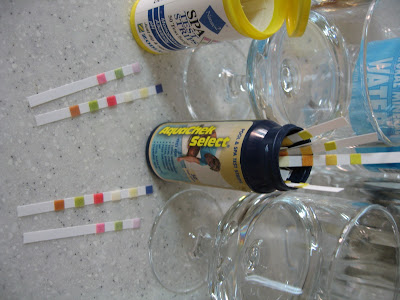What does the number on a fruit sticker mean?
This is a compilation of 3 online sources by RAW EARTH LIVING. Their goal was to uncover the meanings hidden in numbers in those little stickers put on produce in the US so that the consumer can KNOW what he or she is eating ... and if it has been genetically modified, sprayed or is organic.
———————————————————————————————————————–
If there are only four numbers in the PLU, this means that the produce was grown conventionally or “traditionally” with the use of pesticides. The last four letters of the PLU code are simply what kind of vegetable or fruit. An example is that all bananas are labeled with the code of 4011.
If there are five numbers in the PLU code, and the number starts with “8″, this tells you that the item is a genetically modified fruit or vegetable. Genetically modified fruits and vegetables trump being organic. So, it is impossible to eat organic produce that are grown from genetically modified seeds. A genetically engineered (GE or GMO) banana would be: 84011
If there are only four numbers in the PLU, this means that the produce was grown conventionally or “traditionally” with the use of pesticides. The last four letters of the PLU code are simply what kind of vegetable or fruit. An example is that all bananas are labeled with the code of 4011.
If there are five numbers in the PLU code, and the number starts with “8″, this tells you that the item is a genetically modified fruit or vegetable. Genetically modified fruits and vegetables trump being organic. So, it is impossible to eat organic produce that are grown from genetically modified seeds. A genetically engineered (GE or GMO) banana would be: 84011
 |
| Decoding Your Produce |
7 out of 10 items in grocery store shelves contain ingredients that have been genetically modified. Fruit and vegetables do not come with nutrition labels but they do have stickers (PLU – Price Look Up code) which contain pertinent information. Price Look-Up codes, commonly called PLU codes, PLU numbers or PLUs, are identification numbers affixed to produce and other products in grocery stores and supermarkets to make check-out and inventory control easier, faster, and more accurate. The code is a four or five-digit number, identifying the type of bulk produce, usually including the variety.
Organic produce is denoted by a five-digit number whose first digit is 9 (e.g. 94011 for organic yellow bananas); an 8 prefix indicates genetically modified food. The codes have been in use since 1990, and currently, there are over 1300 universal PLU codes assigned.
Use of PLU codes eliminates the need for grocery store checkers to identify each variety of produce visually. This advantage is especially important with the growth of the organic produce market; for example, organic and conventional oranges may look the same but have very different prices.
So, next time you decide to purchase that apple or cut a slice out of that melon, consider the PLU sticker. This sticker will tell you whether the fruit was organically grown, genetically modified, or produced with chemical fertilizers, herbicides or fungicides.
PLU stickers with 4 digits and begin with a “3″ or “4″ - produce is conventionally grown. This means that this produce was sprayed with weed killers and chemical pesticides.PLU stickers with 5-digits and start with “8″ - produce was genetically engineered (man intervened by manipulating the genes to produce a larger or brighter colored food). This produce may have been chemically treated.
PLU stickers with 5-digits and start with “9″ - produce was raised organically. You can be sure that this produce was not treated with any chemicals.
Price Look-Up codes are generally printed on small stickers or tags, and the glue used isn't supposed to be harmful to the body.
Examples: 4139 - conventional Granny Smith apple
94139 - organic Granny Smith84139 - genetically modified Granny Smith
From http://www.seriouseats.com/… and http://www.plantea.com/gene… and all PLU codes http://plucodes.com/search_…
Another Example:APPLES (4173) Variety: Royal GalaVariety Info:Type: GlobalCategory: FRNorth American Size: 100 size and smallerRest of World Size: AFW = less than 205g
If you see other variations of code on your produce, you can refer to the following website and look up the PLU code as well as other information regarding this topic: http://www.fruitsticker.com. The PLU system is administered by the International Federation for Produce Standards, an affiliate of the Produce Marketing Association.
NOTE: the adhesive used to stick the PLU onto the fruit is edible but the sticker itself is not.
COMMENT: having some origin coding would be great for seeing how far a particular fruit/vegetable traveled but that is something still hidden in our giant supermarkets.
~~~~~~~~~~~~~~~~~~~~~~~~~~~~~~~~~~~~~~~~~~~~~~~~~~~~~~~~~~~~~~~~~~~~~
This numbering system is also used in South Korea. My first awareness of this cultural transference was just a couple weeks ago when I saw a huge display of big fat lemons priced at 3/₩1,000 when usually the price is 3/₩2,000 or more much smaller lemons. I bought a whole bag full, and when I got them home, I noticed the number 4???, looked up the meaning online and found out I'd bought a bunch of chemically polluted lemons. I kind of figured that when I saw those cheap beauties, but now I'm wondering how those other lemons I've been buying are classed. Hah, I didn't realize this system was in Korea. I'm gonna teach EVERYBODY!
~~~~~~~~~~~~~~~~~~~~~~~~~~~~~~~~~~~~~~~~~~~~~~~~~~~~~~~~~~~~~~~~~~~~~
And now that the number labeling on fruits is somewhat clear, here is an example of the nutrition of organic and conventionally grown foods. And then just speculate how much less nutritional value is actually in GMO foods than that found in the conventionally grown produce..
~~~~~~~~~~~~~~~~~~~~~~~~~~~~~~~~~~~~~~~~~~~~~~~~~~~~~~~~~~~~~~~~~~~~~
And now that the number labeling on fruits is somewhat clear, here is an example of the nutrition of organic and conventionally grown foods. And then just speculate how much less nutritional value is actually in GMO foods than that found in the conventionally grown produce..







